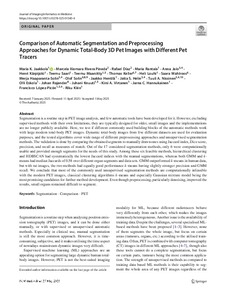Comparison of Automatic Segmentation and Preprocessing Approaches for Dynamic Total-Body 3D Pet Images with Different Pet Tracers
Jaakkola, Maria K.; Rivera Pineda; Marcela Xiomara; Diaz, Rafael; Rantala, Maria; Jalo, Anna; Karpijoki, Henri; Saari, Teemu; Maaniitty, Teemu; Keller, Thomas; Louhi, Heli; Wahlroos, Saara; Haaparanta-Solin, Merja; Solin, Olof; Hentila, Jaakko; Helin, Jatta S.; Nissinen, Tuuli A.; Eskola, Olli; Rajander, Johan; Knuuti, Juhani; Virtanen, Kirsi A.; Hannukainen, Jarna C.; Lopez-Picon, Francisco; Klen, Riku
Comparison of Automatic Segmentation and Preprocessing Approaches for Dynamic Total-Body 3D Pet Images with Different Pet Tracers
Jaakkola, Maria K.
Rivera Pineda
Marcela Xiomara
Diaz, Rafael
Rantala, Maria
Jalo, Anna
Karpijoki, Henri
Saari, Teemu
Maaniitty, Teemu
Keller, Thomas
Louhi, Heli
Wahlroos, Saara
Haaparanta-Solin, Merja
Solin, Olof
Hentila, Jaakko
Helin, Jatta S.
Nissinen, Tuuli A.
Eskola, Olli
Rajander, Johan
Knuuti, Juhani
Virtanen, Kirsi A.
Hannukainen, Jarna C.
Lopez-Picon, Francisco
Klen, Riku
Springer Science and Business Media LLC
Julkaisun pysyvä osoite on:
https://urn.fi/URN:NBN:fi-fe2025082787836
https://urn.fi/URN:NBN:fi-fe2025082787836
Tiivistelmä
Segmentation is a routine step in PET image analysis, and few automatic tools have been developed for it. However, excluding supervised methods with their own limitations, they are typically designed for older, small images and the implementations are no longer publicly available. Here, we test if different commonly used building blocks of the automatic methods work with large modern total-body PET images. Dynamic total-body images from five different datasets are used for evaluation purposes, and the tested algorithms cover wide range of different preprocessing approaches and unsupervised segmentation methods. The validation is done by comparing the obtained segments to manually drawn ones using Jaccard index, Dice score, precision, and recall as measures of match. Out of the 17 considered segmentation methods, only 6 were computationally usable and provided enough segments for the needs of this study. Among these six feasible methods, hierarchical clustering and HDBSCAN had systematically the lowest Jaccard indices with the manual segmentations, whereas both GMM and k-means had median Jaccards of 0.58 over different organ segments and data sets. GMM outperformed k-means in human data, but with rat images, the two methods had equally good performance k-means having slightly stronger precision and GMM recall. We conclude that most of the commonly used unsupervised segmentation methods are computationally infeasible with the modern PET images, classical clustering algorithms k-means and especially Gaussian mixture model being the most promising candidates for further method development. Even though preprocessing, particularly denoising, improved the results, small organs remained difficult to segment.
Kokoelmat
- Rinnakkaistallenteet [27094]
